
The origin and history of Zhuangjin
As one of the four famous brocades in China, the origin of Guangxi Zhuang brocade can be traced back to southern China more than 2,000 years ago. This exquisite handicraft not only embodies the wisdom and creativity of the Zhuang people, but also retains a rich cultural connotation in the process of its evolution. Although the weaving technology of Zhuangjin was simple in the primitive society, it laid its main design mode. In the Han Dynasty, with the improvement of production tools and weaving techniques, the craftsmanship of Zhuangjin gradually became more refined, and showed high artistic value.
In the long history of the Zhuang people, Zhuang brocade has gradually been widely used and has become an important cultural symbol. Especially in the Tang Dynasty, the technology of Zhuangjin reached a peak. The Zhuang brocade of the Tang Dynasty was not only famous locally, but also exported to other regions and became an important commodity in trade. The patterns and designs on the brocade are full of symbolism and are often used in religious ceremonies and important events to symbolize auspiciousness and prosperity.
Entering the Ming and Qing dynasties, the production process of Zhuang brocade was more exquisite, and the style was more diversified. During this period, the brocade not only innovated in techniques, but also paid more attention to the selection of materials, making the texture and color of the brocade more outstanding. Zhuang brocade is not only sought after in China, but also gradually entered the international market, representing the highest level of traditional Chinese brocade craftsmanship.
In modern times, Zhuangjin has been more widely inherited and protected. As an intangible cultural heritage, the history of Zhuang Jin is not only a road of inheritance of skills, but also an important part of Zhuang culture. Whether from a cultural point of view, or from the level of craftsmanship, Zhuangjin has a very high historical value, it connects history and modernity, tradition and innovation, and still glows with new vitality in contemporary times.

Zhuangjin’s process characteristics and production process
Zhuang brocade is a traditional handicraft of the Zhuang people in Guangxi, known for its complex production technology and rich color matching. From material selection to dyeing to weaving, every step of the production process of Zhuangjin is meticulous and exquisite, fully demonstrating the superb skills and pursuit of beauty of the craftsmen.
In terms of material selection, Zhuang brocade usually selects natural silk as the main raw material. Not only is this silk thread silky and tough, but it also absorbs dyes well. To ensure that the colors are vivid and long-lasting, the artisans also choose natural plant dyes for coloring. For example, blue is often used for indication, and red may be for hematoxy. This natural dye is not only eco-friendly, but also has long-lasting color stability.
The dyeing process is a very crucial step in making brocade. The craftsmen will dye the silk threads in a consistent hue according to the needs of the design pattern. During the dyeing process, it is necessary to repeatedly color and dry to ensure the uniformity and color fullness of each thread. This also shows the slow work and sensitivity of the traditional dyeing process.
Weaving is the most complicated part of the whole brocade production process. The craftsmen first carry out a detailed breakdown of the patterns and color blocks according to the designed patterns. Next, they use traditional hand looms to weave together threads of various colors, stitch by stitch. Each complex pattern requires multiple thread changes and color matching, which not only tests the skill of the craftsmen, but also requires great patience and meticulous thought.
The craft characteristics of Zhuangjin are also reflected in the richness of its patterns and national characteristics. The patterns are often taken from life, integrating animals, plants and other elements, reflecting the concept of harmonious coexistence between the Zhuang people and nature. At the same time, the ingenious combination of various geometric patterns makes Zhuangjin have high artistic value.
To sum up, every step of the production process of Zhuang brocade is full of the crystallization of the wisdom and art of the people of Guangxi Zhuang nationality. The use of natural silk and vegetable dyes not only ensures the high quality of Zhuangjin, but also makes it have a strong national color and unique artistic charm.

The cultural and artistic value of Zhuangjin
Zhuang brocade is not only a unique handicraft, but also an important symbol of Zhuang culture. As a microcosm of Zhuang life, the colors and patterns of Zhuang brocade reflect the Zhuang people’s love and understanding of nature and life. On important occasions such as weddings and festivals, Zhuangjin is often used for decoration and gifts, implying good luck and a better life.
The patterns of Zhuangjin are diverse, from ancient natural elements to modern art design, and are innovatively applied to show rich cultural connotations. Common patterns include birds, beasts, flowers, landscapes, and figures, which are carefully woven into colorful splendor, conveying the unique value of the Zhuang people’s aesthetics.
In the traditional wedding of the Zhuang people, the bride often wears a handmade headdress and shawl of Zhuang brocade, which not only adds a festive atmosphere to the wedding, but also conveys the blessings and emotions of the ethnic group. In festivals, Zhuangjin is also widely used to decorate venues and clothing, highlighting a strong national charm.
However, the value of Zhuangjin is not limited to traditional occasions. With the continuous development of modern art design, many designers draw on the elements of Zhuangjin and integrate them into modern fashion, home decoration and other aspects. Through the design concept of keeping pace with the times, Zhuangjin radiates new vitality, which not only inherits the traditional culture, but also caters to the modern aesthetics.
In addition, the Zhuangjin craft has gradually attracted the attention of the international design community. A number of artists and designers have presented their works in international exhibitions, in an effort to bring this traditional craft to a wider stage. This not only enhances the status of Zhuangjin in global culture and art, but also promotes the exchange and integration of Chinese and foreign cultures.
To sum up, Zhuang brocade is not only a kind of exquisite handicraft, but also the cultural and artistic value it carries makes it an important symbol of Zhuang culture. With the continuous innovation and promotion of traditional crafts, Zhuangjin will continue to shine in modern art design and show its unique charm.

The protection and inheritance of Zhuangjin
With the acceleration of modernization, the production process and market demand of Zhuangjin, a traditional handicraft, are facing severe challenges. However, as one of the four famous brocades in China, Zhuangjin’s unique cultural value and historical significance have attracted widespread attention. The government and the private sector have launched a series of efforts to protect and pass on the intangible cultural heritage of Zhuangjin, with a view to preserving and reviving this ancient skill in this wave of modernization.
At the government level, policies and funds are used to support the inheritance and protection of Zhuangjin’s skills. For example, governments at all levels have set up special funds to support the research and promotion of Zhuangjin production technology. At the same time, the local education department works closely with the cultural department to set up training courses on the art of Zhuangjin to teach this traditional skill to the younger generation. In addition, the holding of various cultural exchange activities and exhibitions has also created opportunities for the public to expand the public’s knowledge and understanding of Zhuangjin.
In the private sector, non-profit organizations, social enterprises and individual enthusiasts work together to protect and pass on the Zhuangjin through a variety of ways. Many handicraft workshops and community groups have launched Zhuangjin Skills Experience Programs to give more people the opportunity to experience the process of making Zhuangjin first-hand. In addition, the application of modern technology, such as virtual reality technology and digital display, has enriched the expression of Zhuangjin in contemporary society and attracted a large number of young people to participate in it.
Combined with specific cases, some schools in Guangxi have cooperated with enterprises to set up a Zhuangjin Institute to teach students the weaving skills of Zhuangjin. The enthusiasm and innovative spirit of the younger generation has injected new vitality into this traditional handicraft. They not only inherit the traditional skills, but also through the integration of modern design elements, so that the application of Zhuangjin in fashion and daily necessities is more diversified.
In short, through the joint efforts of the government and the people, Zhuangjin, a precious intangible cultural heritage, is being revitalized. The active participation and innovative practices of the younger generation will ensure that this traditional craft will continue to be passed on and developed in the future.



